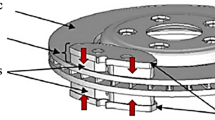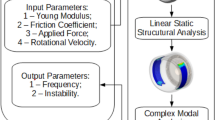Abstract
In the present study, Complex Eigenvalue Analysis (CEA) was used for predicting squeal noise generation in a commercial drum brake. By using a CEA model, Rayleigh damping properties were added to the computer simulation on ANSYS, and a discussion about its implications and proposed calculations are also shown. The Rayleigh damping coefficients (α and β) were obtained through impact tests carried out in a commercial drum brake. Three different cases of damping levels were simulated: (a) Undamped condition, (b) Damped–0 bar, and (c) Damped–2 bar. Results of experimental tests showed that increasing brake pressure from 0 to 2 bar in the damped condition leads to a shift in the resonant frequencies towards higher values, as well as to increase the damping response of the drum brake system. Results of CEA showed a large number of vibration modes occurred within a narrow range of frequencies (0–4500 Hz). This means the drum brake is prone to modal coupling, which may lead to noise generation. The first model simulated by CEA (undamped case) showed five instabilities in the frequency range considered, from this point, the second model was built (damped–0 bar case) and only three instabilities were identified. Thus, the third model (damped–2 bar case) was analyzed and it showed only one unstable frequency, which means over-predictions could be avoided due to the addition of damping. Thus, it was noticed a significant negative offset caused by the damping effect, however, the system instabilities for all five modes remain. CEA models were validated by comparison of predicted and vehicle noise frequencies, which were very close.











Similar content being viewed by others
References
Kinkaid NM, O’Reilly OM, Papadopoulos P (2003) Automotive disc brake squeal. J Sound Vib 267:105–166
Oberst SM (2011) Analysis of brake squeal noise, PhD Thesis, University of New South Wales, School of Engineering and Information Technology
Triches MJ, Gerges SNY, Jordan R (2004) Reduction of squeal noise from disc brake systems using constrained layer damping. J Brazil Soc Mech Sci Eng 26(3):340–348. https://doi.org/10.1590/s1678-58782004000300011
Eriksson M (2000) Friction and contact phenomena of disc brakes related to squeal, PhD thesis, Acta Universitatis Upsaliensis, Uppsala, Sweden
Ruzzi MH (2004) Medições das propriedades dinâmicas de materiais de pastilhas de freios automotivos [Measurements of the dynamic properties of automotive brake pad materials], Master dissertation, Escola Politécnica of the University of São Paulo, São Paulo, Brazil
Masotti D, Rauch B (2015) Methodology to predict brake noise events in a specific route using a dynamometer test, SAE Technical paper (ISSN 0148–7191). In: 12th SAE Brazil International Brake Colloquium & Engineering Display, Brazil
Neis PD, Ferreira NF, Poletto JC (2015) A comparative analysis of original and aftermarkets brake pads sold in the Brazilian market. J Braz Soc Mech Sci Eng 38(7):1935–1945. https://doi.org/10.1007/s40430-015-0440-3
Neis PD, Ferreira NF, Matozo LT, Masotti D, Poletto JC (2015) Definition of a suitable parameter for characterizing creep groan propensity in brake pads, SAE Technical paper (ISSN 0148–7191). In: 12th SAE Brazil International Brake Colloquium & Engineering Display, Brazil
Fuadi Z, Adachi K, Ikeda H, Naito H, Kato K (2009) Effect of contact stiffness on creep-groan occurrence on a simple caliper-slider experimental model. Tribol Lett 33:169–178
Neis PD, Ferreira NF, Poletto JC, Matozo LT, Masotti D (2016) Quantification of brake creep groan in vehicle tests and its relation with stick-slip obtained in laboratory tests. J Sound Vib 369:63–76
Crolla DA, Lang AM (1991) Brake noise and vibration – The state of the art. Vehicle Tribol Leeds-Lyon Tribol Series 18:165–174
Kharate NK, Chaudhari SS (2018) Effect of material properties on disc brake squeal and performance using FEM and EMA approach, Materials Today: Proceedings, [S.L.], 5(2):4986–4994. https://doi.org/10.1016/j.matpr.2017.12.076
Ouyang H, Nack WV, Yuan Y, Chen F (2005) Numerical analysis of automotive disc brake squeal: a review. Int J Veh Noise Vib 1:207–231
Nack WV (1999) Brake squeal analysis by finite elements, SAE Technical Paper 1999–01–1736, https://doi.org/10.4271/1999-01-1736
Oehlmeyer AK (2008) Instabilidade de freios a disco por análise de autovalor complexo [Disc brake noise analysis using instability of complex eigenvalue], Masters dissertation, University of Campinas, São Paulo, Brazil, 119
Miranda MHP, Rodrigues RN, Bezerra RA, Lamary PMC, Oliveira Neto RA (2020) Numerical investigation of material properties and operating parameters effects in generating motorcycle break squeal using the finite element method. J Brazil Soc Mech Sci Eng. https://doi.org/10.1007/s40430-020-02324-3
Balaji V, Lenin N, Anand P, Rajesh D, Raja VKB, Palanikumar K (2021) Brake squeal analysis of disc brake, Materials Today: Proceedings, [S.L.], 46:3824–3827. https://doi.org/10.1016/j.matpr.2021.02.046
Hoffmann N, Fischer M, Allgaier R, Gaul L (2002) A minimal model for studying properties of the mode-coupling type instability in friction induced oscillations. Mech Res Commun 29:197–205
Spelsberg-Korspeter G (2012) Eigenvalue optimization against brake squeal: symmetry, mathematical background and experiments. J Sound Vib 331:4259–4268
Bajer A, Belsky V, Kung SW (2004) The influence of friction-induced damping and nonlinear effects on brake squeal analysis, SAE Technical Paper 2004–01–2794. https://doi.org/10.4271/2004-01-2794
Oberst S, Lai JCS (2015) Squeal noise in simple numerical brake models. J Sound Vib 352:129–141
Massi F, Baillet L, Giannini O, Sestieri A (2007) Brake squeal: Linear and nonlinear numerical approaches, Mechanical System and Signal Processing, pp 2374–2393
Grange P, Clair D, Baillet L, Fogli M (2009) Brake squeal analysis by coupling spectral linearization and modal identification methods, Mechanical System and Signal Processing, pp 2575–2589
Cantone F, Massi F (2011) A numerical investigation into the squeal instability: effect of damping, Mechanical System and Signal Processing, pp 1727–1737
Úradníček J, Musil M, Gašparovič L, Bachratý M (2021) Influence of material-dependent damping on brake squeal in a specific disc brake system. Appl Sci 11(6):2625. https://doi.org/10.3390/app11062625
Esgandari M, Taulbut R, Olatunbosun O (2013) Effect of damping in complex eigenvalue analysis of brake noise to control over-prediction of instabilities: an experimental study, SAE Technical Paper 2013–01–2034, https://doi.org/10.4271/2013-01-2034
Liu P, Zheng H, Cai C, Wang YY, Lu C, Ang KH, Liu GR (2007) Analysis of disc brake squeal using the complex eigenvalue method. Appl Acoust 68:603–615
Silva JGP, Fulco ER, Varante PED, V. Nascimento, F.N. Diesel, D.L. Boniatti (2013) Numerical and experimental evaluation of brake squeal, SAE Technical Paper 2013–36–0030, https://doi.org/10.4271/2013-36-0030
Kun D, Lijun Z, Dejian M, Zhuoping Y (2013) Reliability and precision of complex eigenvalue method for disc brake squeal prediction, Eurobrake, paper number: EB2013-MS-011
Wontae J, Hojoon C, Jeong-tae K (2013) New CAE procedure for reducing brake squeal noise based on mass-stiffness effect, Eurobrake, paper number: EB2013-MS-006
Fritz G, Sinou JJ, Duffal JM, Jézéquel L (2007) Effects of damping on brake squeal coalescence patterns – application on a finite element model. Mech Res Commun 34:181–190
Ali B, Ghazaly NM (2015) Effects of material properties on generation of brake squeal noise using finite element analysis. Latin Am J Solids Struct 12(8)
Kung SW, Dunlap KB, Ballinger RS (2000) Complex eigenvalue analysis for reducing low frequency brake squeal, SAE Technical Paper 2000–01–0444, https://doi.org/10.4271/2000-01-0444
Park SC, Wontae J, Park KH (2012) Improvement of brake squeal using shape optimization based on frequency separation, Eurobrake 2012, paper number: EB2012-MS-027
Dias AL, Rodrigues RN, Bezerra RA, Lamary PMC (2021) Heavy duty automotive drum brake squeal analysis using the finite element method. J Vibr Eng Technol. https://doi.org/10.1007/s42417-021-00346-2
Somnay R, Shih S (2002) Predicting drum brake noise using finite element methods, SAE Technical Paper 2002–01–3139, https://doi.org/10.4271/2002-01-3139
Huang J, Krousgrill CM, Bajaj AK (2006) Modeling of automotive drum brakes for squeal and parameter sensitivity analysis. J Sound Vib 289:245–263
Antunes DS (2016) Metodologia de avaliação de instabilidade dinâmica em freios a tambor utilizando o método dos elementos finitos [Methodology of evaluation for dynamic instability in drum brakes using finite element method], Master dissertation, Engineering School of the Federal University of Rio Grande do Sul, 121
ANSYS Mechanical APDL Structural Analysis Guide, ANSYS Help Documentations
Mohammad DRA, Khan NU, Ramamurti V (1995) On the role of Rayleigh damping. J Sound Vib 185:207–218
Liu M, Gorman DG (1995) Formulation of Rayleigh Damping and its extensions, Computers & Structures, 57(2) Great Britain
Adhikari S, Phani AS (2007) Rayleigh’s Classical damping revisited, international conference on civil engineering in the new millennium: opportunities and challenges, Howrah, India,. Online available on: http://engweb.swan.ac.uk/~adhikaris/fulltext/conference/ftc27.pdf (Accessed 23 April 2018)
B.J. Schwarz, M.H. Richardson, Experimental modal analysis, CSI Reliability Week, Orlando, Fl, 1999.
Bruel & Kjaer, PULSE Reflex application software, PULSE Help Documentation, version 17.1.0
Acknowledgements
The authors acknowledge the financial support of CNPq and CAPES, Brazil.
Author information
Authors and Affiliations
Corresponding author
Ethics declarations
Conflict of interest
Not applicable.
Additional information
Technical Editor: Samuel da Silva.
Publisher's Note
Springer Nature remains neutral with regard to jurisdictional claims in published maps and institutional affiliations.
Rights and permissions
About this article
Cite this article
Antunes, D.S., Masotti, D., Ferreira, N.F. et al. Damping effect on nonlinear drum brake squeal prediction. J Braz. Soc. Mech. Sci. Eng. 44, 97 (2022). https://doi.org/10.1007/s40430-022-03398-x
Received:
Accepted:
Published:
DOI: https://doi.org/10.1007/s40430-022-03398-x




